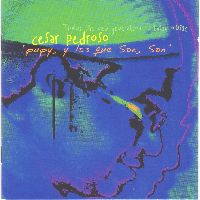Indice - Table of contents
New Stuff[hide]
Musicos: Rafael Paseiro Monzón
Musicos: Dennis Nicles Cobas
Musicos: Jiovanni Cofiño Sánchez
Musicos: Yasser Morejón Pino
Fotos: Tom Ehrlich : 2024 Monterey Jazz, P...
Resenas: Vacilón Santiaguero (Circle 9 ...
Staff: Bill Tilford
Fotos: Tom Ehrlich : 2024 Monterey Jazz, P...
Fotos: Tom Ehrlich : 2024 Monterey Jazz Fe...
Fotos: Tom Ehrlich : testing 123
Grupos: Pupy y los que S... : Discography - 1995- F...
Reportes: From The St... : Cubadisco 2...
Reportes: From The St... : Jazz Plaza ...
Fotos: Tom Ehrlich : Irakere 50th Annivers...
Photos of the Day [hide]
SpanishEnglishDiscography - 2001 - Qué cosas tiene la vida - compared to "Timba: The New Generation"
 Let's start by taking a look at Pupy's previous CD, "Timba: The New Generation of Latin Music", which has six songs in common with the new one. It was recorded before Pupy left Van Van -- before he had his own working band -- and as such it had the feeling of a "project" -- as if they said "ok, let´s see what happens with this combination of famous musicians from other groups". It was a great album, with the same creative energy and with great playing. The first album, remember, had an all-star lineup including Changuito, Candelita, Boris Luna, "El Indio" and many others. But now, after having heard the new album I can say that the first was like a snowball which has now become an avalanche. Now we have a stable band with disciplined and dedicated members who have played together extensively and who are heavily invested in the identity of the band.
Let's start by taking a look at Pupy's previous CD, "Timba: The New Generation of Latin Music", which has six songs in common with the new one. It was recorded before Pupy left Van Van -- before he had his own working band -- and as such it had the feeling of a "project" -- as if they said "ok, let´s see what happens with this combination of famous musicians from other groups". It was a great album, with the same creative energy and with great playing. The first album, remember, had an all-star lineup including Changuito, Candelita, Boris Luna, "El Indio" and many others. But now, after having heard the new album I can say that the first was like a snowball which has now become an avalanche. Now we have a stable band with disciplined and dedicated members who have played together extensively and who are heavily invested in the identity of the band.
The members of Los Que Son Son have built their roles on the concepts introduced on the previous record. For example, bassist Rafael Paceiro has changed his style considerably to adapt to Pupy's music. Paceiro, remember, was the longtime Bamboleo bassist who came up with some of the best and most innovative Timba basslines ever invented. Listen to his bass tumbao on Bamboleo's "La Tremenda" [audio example]. [2009: we've since learned that this particular tumbao was created by Paceiro's predecessor, Frank Rubio]

With Pupy, Paceiro moves over to the upright bass and plays much straighter tumbaos, often closely tied to the piano, such as this one on the title track [audio example].
![]()
The excerpt above is also an excellent example of Pupy's approach of developing rhythmic motives bewteen the bass and piano -- something he himself describes in his interview with Majela Serrano.





















